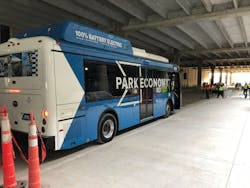As part of its $1.5 billion new terminal project at Kansas City International Airport (MCI), the Kansas City Aviation Department invested in a wireless inductive vehicle charging system from Momentum Dynamics Corporation.
Momentum powers all types of electric vehicles using a modular platform technology for the automatic charging of vehicles. There’s nothing to plug into. Inductive charging utilizes an inductive ground assembly and an inductive vehicle assembly. The ground assembly can be installed flush with the ground or surface mounted.
“We are designing and building a modern new terminal and we want to make sure that its support infrastructure does not detract from the design,” said MCI Fleet Manager Aaron Kaden. “Inductive charging was not only an efficient solution in terms of monetary outlay and ongoing costs but was the only system we found that can deliver energy without the traditional plug-in infrastructure.”
With inductive charging, there’s no need to take buses out of service for charging. Frequent incremental charging will be provided to MCI Economy Parking electric shuttle buses. Buses can stay in service along the seven-mile loop.
Two chargers will support the entire MCI parking fleet of about 28 vehicles (buses). The 300 kW wireless inductive chargers will be located at shuttle bus stops at the new terminal (just outside of the baggage claim area). While waiting for passengers, bus drivers will park the buses over the inductive charging pads and charging will begin automatically within 5 seconds of the brake being applied. Charging will automatically end when the bus departs from the pad.
“We have the first wireless charging installation at an international airport that we’re aware of globally,” said Kevin Fisher, director of truck systems electrification at Momentum.
Fisher described what types of vehicles could benefit from the technology at airports. On the landside, he said passenger vehicles, taxis, shuttles and buses could take advantage of this technology. On the airside, any ground support equipment that has a compatible high voltage level battery system could use the system that operates between 400 and 800 VDC.
“In general, what we promote is less chargers to charge more vehicles by deploying en route or opportunity charging, and there’s lots of benefits to that,” he said.
Wireless charging provides the opportunity for a total lower cost of ownership for the charging infrastructure and helps facilitate high utilization of the charging infrastructure, he said. “You can spread that capital cost across more vehiclesn and it also facilitates a higher utilization for vehicles that can take advantage of this approach,” he said.
Another benefit of the inductive charging process is that they demand less real estate. “When you think of a conductive charging with cords and plugs, generally, they have the same power electronics cabinet that we have,” Fisher said. “They also have a pedestal, with bollards around it to protect it and then cords and plug so you effectively diminish some of your parking capacity with the charging infrastructure. Our setup has a power and electronics cabinet and everything else is underground. We actually hope in future generations to take the power electronics cabinet and put it in the ground as well.”
THE CHARGING PROCESS
The charging process has two basic parts: an inductive ground charger and a matching vehicle assembly that will receive the inductive charge.
Fisher described: “Instead of cords and plugs, it’s magnetic resonant inductive charging from the ground pad to the vehicle pad. So it requires modification or upgrading to the vehicle to include our vehicle assembly, which connects passively to the vehicle cooling system. We prefer to connect directly to the high voltage circuit in the battery management system. We also deploy a direct connection to CAN bus for the battery management system. This approach allows us to be OEM agnostic. We rely totally on the vehicle battery management system for asking how much power and when. It’s totally relying on the BMS on the vehicle itself.”
The number of pads included in a charger is dependent on the vehicle battery. A four-pad, 300 kW system, like the two at MCI, are delivering a DC fast-charge Level 3 charging. Level 3 is 24 to 300 kW, which Fisher said means adding 75 to 1,200 miles of range and 30 to 40 minutes on a 60 kW battery.
Fisher said, “You hear about megawatt changing that’s putting a lot of power in very quickly. The faster you push the power in, the more damaging to the vehicle, and that’s not what this is.”
A charging pad is 600mm by 600 mm, 65 mm thick and weighs 70 pounds. “That’s the building block of our modular setup and that’s 75 kW,” he said. “The output is the equivalent of a Tesla fast charger and it’s sufficient for most cars and light duty vans. When we need more power, we add pad. We look at the fleet mix. Many fleets have light, medium and heavy-duty vehicles involved so we would typically advocate for a four-pad 300 kW system out of the gate.”
To determine charging system requirements, the operational flow of vehicles is considered. “Airport shuttles are usually running in a fairly defined route and they only have to charge periodically,” he said. “So if you can tie that into the operation, dropping off passengers and picking up passengers, that’s usually a sufficient amount of charge and you can actually wind up in many cases putting a smaller battery pack in because you don’t need the range on those short, shuttle-type runs and that allows you to lower the cost of the vehicle, reduce the weight and make it more efficient.”
BUSES AT MCI
In 2017, the Kansas City Aviation Department was the first U.S. airport operator to use all electric buses when it added four BYD buses to its fleet and three more in 2020.
Initially, MCI’s plan for inductive charging was to retrofit four existing BYD K7 30-foot electric buses with the wireless system to enable automatic battery charging. An MCI spokesperson said in September this option is being further evaluated.
Jason Yan said the current buses MCI has do not have the wireless charging system installed. MCI will have the BYD K7M 30-foot electric buses with a wireless charging system. The K7M seats up to 22 people and has a short turning radius. Batteries are iron-phosphate and come with a 12-year warranty, and the battery capacity of the K7M bus is 215kWh. With a fully charged battery, the K7M can travel up to 158 miles. The maximum acceptable charging power is 150kW. Charging time is 1.5 to 2 hours with overhead charging or 2 to 2.5 inductive charging. Yan clarified the charging power of a overhead charging system theoretically is higher than a wireless charging system. But, he said for the K7M, because of its size, the max charging power and charging should be similar or about the same.
Yan noted more and more airports are looking at inductive charging.
The new MCI terminal will open in late February or early March 2023.
About the Author
Rebecca Kanable
Assistant Editor
Rebecca Kanable, a veteran journalist, worked with Endeavor Business Media's aviation group from 2021 to 2024 as assistant editor of Airport Business, AMT and Ground Support Worldwide. She previously worked for various publications, including trade magazines and newspapers.

